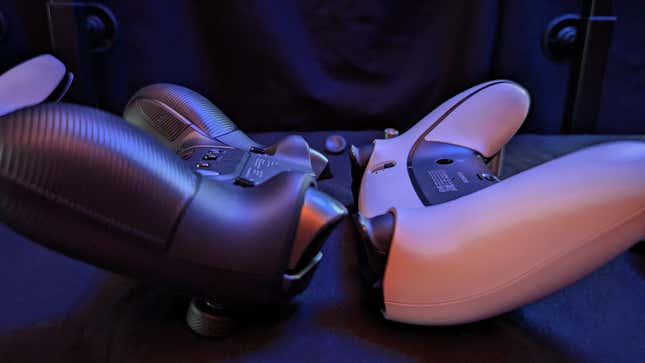The design of the video game console as we know it has remained largely the same over the past 20 years: a directional pad, two analog sticks, four face buttons, and four shoulder buttons. It continues from PlayStation’s first DualShock, all the way to the modern PS5’s DualSense, as well as various Xbox and Nintendo consoles.
Recent years have seen the rise of ‘Elite’ and ‘Pro’ controllers that promise to deliver extra performance, mostly in competitive gaming where keeping your thumbs on the analogue sticks whenever possible gives you an advantage over your opponents. The Nacon Revolution 5 Pro controller for PS5, PS4, and PC is a relatively new contender in this market, and it promises four buttons on the back and, perhaps most attractively, a joystick that will never stray.
As a hybrid gamepad for PlayStation and PC, the Revolution 5 Pro is surrounded by offerings from both Sony and Microsoft. It comes at a price of $200, and it competes directly with Sony’s professional controller, which is DualSense Edge (Which is at the same price point). On the PC front, the Xbox Elite controller drops its price by about $30. However, none of the Revolution 5’s first-party rivals offer drift-free analog sticks (although you can buy third-party non-drift analog sticks for the DualSense Edge that slot in directly).
But while its anti-drift technology makes a strong case for including it in your gaming arsenal, in my experience, the Nacon Revolution 5 Pro is somewhat uncomfortable to use.
Great on paper but a pain in the hands
The Revolution 5 Pro has a lot of great specs: four permanently positioned and mappable back buttons on the device with quick button combination and four different profiles; two interchangeable D-pads (one traditional T-shaped one and the “satellite dish” common on Xbox consoles); Three pairs of weights that you can input into the controller to change its heaviness; Interchangeable joystick rings with two different thicknesses and six interchangeable joystick heads; Wireless support for both PC and PlayStation (you need to sacrifice a USB port if you want to use it wirelessly on PlayStation), two degrees of adjustable trigger throw range for both minimum and full depth as well as full PlayStation gyroscope support.

What causes drift?
Controller drift is a modern affliction of gaming technology, the result of wear and tear or debris buildup inside your average analog stick Voltage technology. Almost all controllers that use potentiometers will succumb to this sooner or later. Like the Sega Saturn and Dreamcast consoles before it, the Revolution 5 Pro features “Hall effect“Analog sticks, which use magnets for non-contact signal communications. The results? There are no physical parts inside rubbing against each other, so this thumb stick won’t succumb to the same wear and tear that potentiometers do.”
The Revolution 5 has an asymmetrical trackpad layout, which might rub you the wrong way if you’re a PlayStation fan — I prefer symmetrical layouts, but I was excited to try this out. Unfortunately, despite the impressive list of features, this controller and I never really got along.
The Revolution 5’s ergonomic problems lie in two places: the shoulder buttons and the curve below L2/R2 where your middle or ring finger rests. On the second point, the controller seems to either want to sit forward in my hand, or tilt back, so I often fidget with it while playing. I think this is what gave me a noticeable drop in gameplay performance in shooting games like Infinite aura On PC – I was very distracted trying to get the controller to sit nicely in my hands. More worryingly, long sessions could cause my hands to go numb or cramp up in ways that other, more ergonomic controllers don’t.

For the record, I’m an ardent lover of the traditional Xbox “Duke” controller and often play wide-necked, 8-string baritone scale guitars when I’m not playing. So hand size and large items are not a problem for me.
And the shape and placement of the shoulder button makes the Revolution 5 look like it’s not sure whether it wants to be a PlayStation or Xbox controller. When the Xbox 360 arrived in 2005, it repositioned the OG Xbox’s “black and white” buttons on the shoulders. But they do so as “bumpers,” distinguishing them from the PlayStation controller in a way that encourages you to use the sides of your index fingers to activate them. This has the advantage of allowing you to keep your index or “trigger” fingers on… well, the triggers. This makes it a great design for shooters.
Xbox controllers, especially newer ones, have a gentle concave notch in the bumpers that accommodates the top shape of the tip of your index finger, or “Distal phalanxHowever, PlayStation controllers more traditionally require a two-finger forked grip from players, although recent DualShock 4 and DualSense controllers have enough of a curved shape on the L1/R1 that you can get away with a similar grip to what you’d use. On Xbox.
However, the Revolution 5 doesn’t feature the concave curve of Xbox bumpers nor the gentle slope inside the DualSense. The L1/R1 buttons end at a hard 90-degree angle that doesn’t accommodate a standard Xbox grip. But since it looks more like an Xbox controller in the shoulder area, it doesn’t feel comfortable using the PlayStation’s forked two-finger grip either.
This difference meant that while playing I kept switching my grips. I think that was another reason for my performance aura It got worse: I was too distracted trying to find a way to hold this feature-rich controller comfortably and reliably.
However, at the end of the day, the effects of an onboard lounge should not be underestimated. Nowadays, console drift seems to get worse with each new generation, so spending a significant amount of money on a console that will outlast two or three of them is definitely tempting.
Solution for old consoles?
The Revolution 5’s use of non-flow hall effect technology makes me think of its usefulness as a way to extend the life of the PS4, which over time will have difficulty securing the DualShock 4s. The same can be said about the PS5 as it ages. Yes, there are other ways controllers can cause problems and fail (I recently saw a cheerfully designed Xbox Wireless Controller with a d-pad randomly clicking on itself), but drift remains one of the most insidious and difficult problems to fix.
Despite the issues I have with comfort (or lack thereof), I think there’s value in the Revolution 5 Pro as a long-term purchase — even though at $200, that’s still kind of steep. Sure, you can replace the joystick on a similarly priced DualSense Edge, thus extending its life, but that increases its cost.
The Revolution 5 Pro impresses on paper and has a premium feel – a feeling that’s unfortunately distorted by some uncomfortable design choices. There’s good reason to consider getting one for its extra customization, four back buttons, and fancy control buttons, but you may want to hold one before purchasing to see if it’s a good fit — literally.




